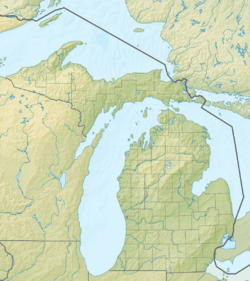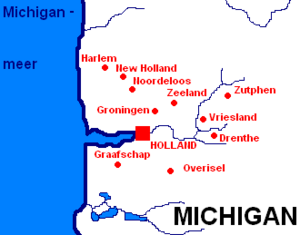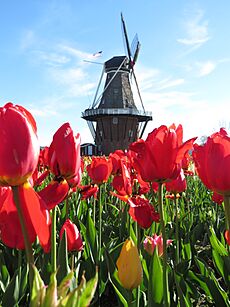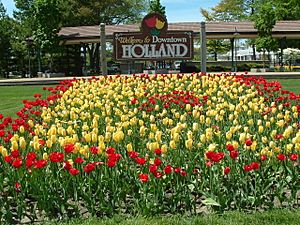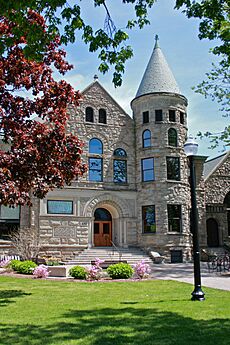Holland, Michigan facts for kids
Quick facts for kids
Holland, Michigan
|
|
|---|---|
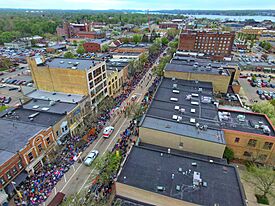
Downtown during the Tulip Time Festival
|
|
| Nickname(s):
The Tulip City
|
|

Location within Ottawa County
|
|
| Country | United States |
| State | Michigan |
| Counties | Allegan and Ottawa |
| Settled | 1847 |
| Incorporated | 1867 |
| Area | |
| • Total | 17.45 sq mi (45.20 km2) |
| • Land | 16.68 sq mi (43.21 km2) |
| • Water | 0.77 sq mi (1.99 km2) |
| Elevation | 610 ft (186 m) |
| Population
(2020)
|
|
| • Total | 34,378 |
| • Estimate
(2023)
|
34,540 |
| • Density | 2,070.74/sq mi (799.52/km2) |
| Time zone | UTC−5 (Eastern (EST)) |
| • Summer (DST) | UTC−4 (EDT) |
| ZIP code(s) |
49422–49424
|
| Area code(s) | 616 |
| FIPS code | 26-38640 |
| GNIS feature ID | 0628421 |
Holland is a city in Ottawa and Allegan counties in the U.S. state of Michigan. Located in the western region of the Lower Peninsula, the city is situated near the eastern shore of Lake Michigan on Lake Macatawa, which is fed by the Macatawa River. As of the 2020 census, the population was 34,378, with an urbanized area population of 107,034.
Holland was founded by Dutch Americans and is in an area that has a large percentage of citizens of Dutch American heritage. It is home to Hope College and Western Theological Seminary, institutions of the Reformed Church in America. Holland's economy includes manufacturing, agriculture, tourism, and higher education. It is home to a number of prominent companies, including Herman Miller, Haworth, and Adient. The city also attracts thousands of visitors each year for its annual Tulip Time Festival, which celebrates the area's Dutch heritage and tulip fields.
The city spans the Ottawa/Allegan county line, with 9.08 sq mi (23.52 km2) in Ottawa and the remaining 8.13 sq mi (21.06 km2) in Allegan. Holland is the largest city in both Ottawa and Allegan counties. The Ottawa County portion is part of the Grand Rapids metropolitan area, while the Allegan County portion anchors the Holland micropolitan statistical area, which is coextensive with Allegan County. The city is part of the larger Grand Rapids–Wyoming combined statistical area.
Contents
History
Ottawa County was originally populated by Ottawa Indians. In 1846, Reverend George Smith established the Old Wing Mission as an outreach to the native population. The Ottawa living here were primarily practicing Catholics, but Smith tried converting them to Protestantism. While generally unsuccessful in converting the Native population, the two groups worked together relatively closely for a short time. This attempt to work and live together was not valued by the next group who arrived.
Holland was settled in 1847 by Dutch Calvinist separatists, under the leadership of Dr. Albertus van Raalte. Dire economic conditions in the Netherlands compelled them to emigrate, while their desire for religious freedom led them to unite and settle together as a group.
Van Raalte and his colony settled on land in the midst of the Ottawa (Odawa) people's Old Wing Mission Colony near the Macatawa River (also known as the Black River) where it streams into Lake Macatawa (Called Black Lake prior to June 4, 1935) which, in turn, leads to Lake Michigan via a channel. The Dutch settlers and the Ottawa people never got along. Dutch settlers began stealing sugar and venison from the Ottawa. The Dutch were unwilling to accept the Ottawa people's mix of Catholic and Native culture. Soon, Dutch leaders tried to force the natives into wooded land in Allegan County. Eventually, the natives moved north to preserve their way of life and culture. Chief Peter Waukazoo and Reverend George Smith decided to move the community and the Ottawa Mission from Holland up to Northport (on the Leelanau Peninsula), voyaging on boats and canoes.
In Holland's early history, Van Raalte was a spiritual leader, as well as overseeing political, educational and financial matters. In 1847, Van Raalte established a congregation of the Reformed Church in America, which would later be called the First Reformed Church of Holland. On March 25, 1867, Holland was incorporated as a city with Isaac Cappon being the city's first mayor.
October 1871 Fire
The city suffered a major fire on October 8–10, 1871, at the same time as the Great Chicago Fire in Illinois and the very deadly Peshtigo Fire in Wisconsin. Due to the Great Michigan Fire (which included the Port Huron Fire of 1871), Manistee and Port Huron, Michigan, also burned at the same time. Also known as the Great Midwest fires, the series of fires across Michigan claimed approximately 500 lives, though the exact death toll remains unknown. The vast majority of downtown burned in the fire, claiming 1 life in the aftermath of the fire. The exact cause of the fire remains unknown. There are a number of theories about what caused the fire. The congruence with the Chicago fire has led to some claims of a link, such as embers floating over Lake Michigan to start the Holland Fire. However, one of the theories are rather fantastical and fairly unlikely, that burning methane gas from a passing comet lead to the fires. The most likely explanation remains that strong winds strengthened a small brush fire, first igniting the nearby forests before burning the town itself. However, no definitive explanation for the fires have ever been given, and the exact cause remains unknown.
Geography
Holland is located at 42.7875235, -86.1089301.
According to the United States Census Bureau, the city has a total area of 17.450 sq mi (45.20 km2), of which, 16.683 sq mi (43.21 km2) is land and 0.767 sq mi (1.99 km2) is water.
Neighborhoods
- Holland Heights
Climate
Holland has a Midwestern humid continental climate (Köppen Dfb/Dfa) that is influenced by the Great Lakes, and is part of USDA Hardiness zone 5b.
| Climate data for Holland, Michigan (West Michigan Regional Airport) 1991–2020 normals, extremes 1905–present | |||||||||||||
|---|---|---|---|---|---|---|---|---|---|---|---|---|---|
| Month | Jan | Feb | Mar | Apr | May | Jun | Jul | Aug | Sep | Oct | Nov | Dec | Year |
| Record high °F (°C) | 67 (19) |
70 (21) |
85 (29) |
90 (32) |
95 (35) |
101 (38) |
102 (39) |
101 (38) |
99 (37) |
89 (32) |
78 (26) |
70 (21) |
102 (39) |
| Mean maximum °F (°C) | 52.6 (11.4) |
53.7 (12.1) |
68.6 (20.3) |
79.0 (26.1) |
85.8 (29.9) |
91.3 (32.9) |
92.5 (33.6) |
90.5 (32.5) |
88.3 (31.3) |
79.5 (26.4) |
65.5 (18.6) |
55.4 (13.0) |
94.1 (34.5) |
| Mean daily maximum °F (°C) | 31.8 (−0.1) |
34.3 (1.3) |
44.4 (6.9) |
56.8 (13.8) |
68.6 (20.3) |
78.1 (25.6) |
81.7 (27.6) |
80.2 (26.8) |
73.5 (23.1) |
60.8 (16.0) |
47.6 (8.7) |
36.9 (2.7) |
57.9 (14.4) |
| Daily mean °F (°C) | 25.9 (−3.4) |
27.4 (−2.6) |
36.0 (2.2) |
47.1 (8.4) |
58.3 (14.6) |
67.9 (19.9) |
71.6 (22.0) |
70.0 (21.1) |
62.9 (17.2) |
51.7 (10.9) |
40.7 (4.8) |
31.5 (−0.3) |
49.3 (9.6) |
| Mean daily minimum °F (°C) | 19.9 (−6.7) |
20.5 (−6.4) |
27.6 (−2.4) |
37.4 (3.0) |
47.9 (8.8) |
57.7 (14.3) |
61.6 (16.4) |
59.9 (15.5) |
52.4 (11.3) |
42.6 (5.9) |
33.8 (1.0) |
26.2 (−3.2) |
40.6 (4.8) |
| Mean minimum °F (°C) | 0.1 (−17.7) |
2.8 (−16.2) |
9.4 (−12.6) |
23.5 (−4.7) |
33.8 (1.0) |
42.9 (6.1) |
49.6 (9.8) |
48.2 (9.0) |
38.3 (3.5) |
29.4 (−1.4) |
21.0 (−6.1) |
9.6 (−12.4) |
−3.7 (−19.8) |
| Record low °F (°C) | −21 (−29) |
−24 (−31) |
−9 (−23) |
5 (−15) |
20 (−7) |
29 (−2) |
40 (4) |
36 (2) |
27 (−3) |
19 (−7) |
−13 (−25) |
−17 (−27) |
−24 (−31) |
| Average precipitation inches (mm) | 1.87 (47) |
1.77 (45) |
2.07 (53) |
3.50 (89) |
3.76 (96) |
3.45 (88) |
2.80 (71) |
3.06 (78) |
2.95 (75) |
4.22 (107) |
3.20 (81) |
2.11 (54) |
34.76 (883) |
| Average precipitation days (≥ 0.01 in) | 14.0 | 12.9 | 10.5 | 12.7 | 12.8 | 11.0 | 9.9 | 10.9 | 11.1 | 14.1 | 12.6 | 13.8 | 146.3 |
| Source: NOAA | |||||||||||||
Demographics
| Historical population | |||
|---|---|---|---|
| Census | Pop. | %± | |
| 1870 | 2,319 | — | |
| 1880 | 2,620 | 13.0% | |
| 1890 | 3,945 | 50.6% | |
| 1900 | 7,790 | 97.5% | |
| 1910 | 10,490 | 34.7% | |
| 1920 | 12,183 | 16.1% | |
| 1930 | 14,346 | 17.8% | |
| 1940 | 14,616 | 1.9% | |
| 1950 | 15,858 | 8.5% | |
| 1960 | 24,777 | 56.2% | |
| 1970 | 26,337 | 6.3% | |
| 1980 | 26,281 | −0.2% | |
| 1990 | 30,745 | 17.0% | |
| 2000 | 35,048 | 14.0% | |
| 2010 | 33,051 | −5.7% | |
| 2020 | 34,378 | 4.0% | |
| 2023 (est.) | 34,540 | 4.5% | |
| U.S. Decennial Census 2020 Census |
|||
2020 census
| Race | Number | Percentage |
|---|---|---|
| White (NH) | 22,641 | 65.9% |
| Black or African American (NH) | 1,279 | 3.7% |
| Native American or Alaska Native (NH) | 76 | 0.2% |
| Asian (NH) | 913 | 2.7% |
| Pacific Islander (NH) | 30 | 0.1% |
| Some Other Race (NH) | 106 | 0.3% |
| Mixed/Multi-Racial (NH) | 1,291 | 3.8% |
| Hispanic or Latino | 8,042 | 23.4% |
| Total | 34,378 | 100.0% |
As of the 2020 census, there were 34,378 people, 12,747 households, and 7,880 families residing in the city. The population density was 2,060.7/sq mi (795.6/km2). There were 13,512 housing units. The racial makeup of the city was 71.2% White, 4.2% African American, 0.8% Native American, 2.8% Asian, 0.1% Pacific Islander, 9.4% from some other races and 11.5% from two or more races. Hispanic or Latino of any race were 23.4% of the population. 20.4% of residents were under the age of 18, 5.1% were under 5 years of age, and 16.9% were 65 and older.
2010 census
As of the 2010 census, there were 33,051 people, 12,021 households, and 7,593 families residing in the city. The population density was 1,992.3/sq mi (769.2/km2). There were 13,212 housing units at an average density of 796.4/sq mi (307.5/km2).
Race and Hispanic or Latino Origin: The racial makeup of the city was 80.0% White alone, 3.6% Black or African American, 0.6% Native American, 3.0% Asian, 0.1% Pacific Islander, 9.2% from some other races and 3.4% from two or more races. Hispanic or Latino of any race were 22.7% of the population.
There were 12,021 households, of which 32.8% had children under the age of 18 living with them, 46.5% were married couples living together, 11.9% had a female householder with no husband present, 4.7% had a male householder with no wife present, and 36.8% were non-families. 29.8% of all households were made up of individuals, and 13.5% had someone living alone who was 65 years of age or older. The average household size was 2.52 and the average family size was 3.13.
The median age in the city was 31.7 years. 24% of residents were under the age of 18; 16.5% were between the ages of 18 and 24; 24.7% were from 25 to 44; 21% were from 45 to 64; and 13.7% were 65 years of age or older. The gender makeup of the city was 47.5% male and 52.5% female.
Economy
Holland is home to the world's largest pickle factory. The H.J. Heinz Company opened the factory at the same location in 1897, and processes over 1 million lbs. of pickles per day during the green season.
- Adient - automotive seating
- Haworth - office furniture
- Herman Miller - home and office furniture
- Johnson Controls - lithium-ion batteries
- LG Chem - lithium-ion batteries
- Tiara Yachts - luxury yachts/wind turbines
- Kraft Heinz - pickles, sauces, mustards
- Magna - engineered glass and mirrors
Arts and culture
The city is perhaps best known for its Dutch heritage, which serves not only as a part of the city's cultural identity, but the local economy as well: the Tulip Time Festival in May and various Dutch-themed attractions augment the nearby Lake Michigan shoreline in attracting thousands of tourists annually. Over 28% of the population identified as being of Dutch descent.
The Holland Museum contains exhibits about the city's history. Another, the Cappon House Museum, was built in 1874 and is a historic museum that once housed the first mayor of Holland, Dutch immigrant Isaac Cappon. The Settlers House Museum, a building that survived the great fire, contains furnishings and relics from the 19th century.
Holland's downtown is listed in the National Register of Historic Places. The "Snowmelt Project" established pipes transporting warm water from the nearby power plant to travel underneath downtown with the purpose of clearing the streets and sidewalks in the downtown area of any snow.
De Zwaan, an original 250-year-old Dutch windmill, is situated on Windmill Island, a municipal park. Its height is 125 ft (38 m) with 40 ft (12 m) sails.
Holland boasts an annual Fiesta, organized by Latin Americans United for Progress, usually on the Saturday closest to May 5 (Cinco de Mayo). Holland is also host to the annual Tulipanes Latino Art & Film Festival, which is held to celebrate the Latino contribution to the culture.
Religion
Holland is known as the "City of Churches". There are around 140 churches in the greater Holland area, many of which are with the Reformed Church in America and Christian Reformed Church in North America denominations. The city is the home to the church that started the trend of the "What Would Jesus Do?" bracelets in 1989.
Tourism
Each May, Holland hosts an annual Tulip Time Festival. Tulip planting and the festival began in 1930 when 250,000 tulips were planted for the event. Currently six million tulips are used throughout the city. Tulips are planted along many city streets, in city parks and outside municipal buildings as well as at tourist attractions like Dutch Village, the city-owned Windmill Island Gardens, and at a large tulip farm named Veldheer Tulip Gardens. It is normally held the second week of May, during the tulip blooming season. Cruise ships such as the Yorktown from the Great Lakes Cruising Company make Holland a port of call.
About one million tourists visit Tulip Time each year, for which the community finds innovative ways to enhance self-funded projects. The Tulip Time Festival has attracted big-name acts in recent years such as: Christina Aguilera in 2000, O-Town in 2001, the Verve Pipe in 2004, and Jars of Clay in 2006. Ed McMahon visited Tulip Time in 2007 along with Bobby Vinton. Comedian Bill Cosby headlined the 2014 Tulip Time Festival.
Holland is located on Lake Macatawa, near the shores of Lake Michigan. Scattered along the shoreline are many public beach accesses including Tunnel Park and the widely popular Holland State Park. Across the channel from the State Park is the Holland Harbor Light, known as "Big Red". Smaller beaches along Lake Michigan are present but not well marked. Public accesses are frequent along dead-end streets bordering the shoreline.
The city's primary shopping district is centered along 8th Street, the city's main street downtown.
The 8th Street business district features a thermal snow-melting system which uses cooling water from the local electric plant. In 1988, the city rebuilt the entire street and sidewalk system, installing the thermal pipes underneath. The system will melt up to an inch an hour down to 15°.
Art
- Holland Area Arts Council
Music
- Holland Chorale, Holland's auditioned chorus, presenting a full concert season of fine choral music
- Holland Symphony Orchestra, professional symphony orchestra conducted by Maestro Johannes Müller-Stosch.
Sports
| Logo | Club | Sport | League | Venue | Championships |
| Holland Blast | Basketball defunct team | International Basketball League | Holland Civic Center | None | |
| Hope College Flying Dutchmen football | College football | Michigan Intercollegiate Athletic Association | Ray and Sue Smith Stadium |
Education
Higher level academic institutions
- Hope College, a private four-year liberal arts college
- Western Theological Seminary, a graduate and professional school
- Grand Valley State University, with a campus in Holland (land donated to GVSU by the Meijer family)
- Davenport University, with a regional campus in Holland
- Grand Rapids Community College, Lakeshore Campus
Public schools
- Holland Public Schools
- West Ottawa Public Schools, which serve the townships that comprise Holland's suburban and rural north side
- Black River Public School, a charter school with kindergarten, elementary, secondary, and high school students
- Vanderbilt Charter Academy (K-8)
- Thompson M-TEC (Adult Training), a partnership between the Ottawa Area Intermediate School District and Grand Rapids Community College
- Eagle Crest Charter Academy
Private schools
- Holland Christian Schools (includes Holland Christian High School)
- Corpus Christi Catholic School
- Calvary Schools of Holland
- Holland Seventh-day Adventist School
Transportation
The city is serviced by West Michigan Regional Airport (IATA: BIV, ICAO: KBIV), the Park Township Airport (IATA: HLM, ICAO: KHLM) having closed on August 15, 2020. The airport is not served by regularly scheduled commercial carriers; the nearest airport with airline service is Gerald R. Ford International Airport in Grand Rapids, Michigan, about 35 mi (56 km) northeast.
The city also is served by regularly scheduled Amtrak service (the Pere Marquette) east to Grand Rapids and west to Chicago with connections to all points east and west.
The city and surrounding area is served by the MAX (Macatawa Area Express) transportation system, which offers both on-demand and high-speed bus service, linking different parts of the city as well as commercial, medical and government locations outside the city. This service evolved from the former "Dial-A-Ride Transportation" (DART) system.
The city is served by the following highways:
 I-196 (Gerald R. Ford Freeway)
I-196 (Gerald R. Ford Freeway) BL I-196
BL I-196 US 31
US 31 M-40
M-40 A-2
A-2
The channel between Lake Macatawa and Lake Michigan allows pleasure craft and commercial boats, even bulk freighters, to access Holland's docks to unload coal, salt and iron scrap.
Media
Newspapers
- Holland Sentinel, Holland's local daily newspaper/online edition
- Grand Rapids Press, formerly maintained a Holland newsroom and circulation office
Radio
- WHTC, 1450 WHTC and The New 99.7 FM
- WYVN, classic Hits for Holland and the Lakeshore, 92.7 FM
- WTHS - Hope College radio station, 89.9 FM
Television
- HCTV, Holland local television station
Notable people
Holland is the hometown of four Medal of Honor recipients (tied with Pueblo, Colorado which has four, both more than any other municipality in the United States) – John Essebagger Jr., Paul Ronald Lambers, Matt Urban, and Gordon Douglas Yntema.
- Harry Bannister, actor
- L. Frank Baum (d. 1919), author of The Wonderful Wizard of Oz, had a holiday home named The Sign of the Goose in the resort community of Macatawa
- Franklin Cappon, basketball coach, Michigan and Princeton
- Charles F. Conrad, founder of Lake Michigan Carferry Service
- Kirk Cousins, quarterback for Michigan State University and NFL's Atlanta Falcons
- Brian D'Amato, author (Beauty, In the Courts of the Sun and its sequel The Sacrifice Game) and sculptor
- Robert Danhof, jurist
- Hopwood DePree, film producer, co-founder of Waterfront Film Festival
- Betsy DeVos, U. S. Secretary of Education, 2017 - 2021
- Max DePree, writer; industrialist; former CEO of Herman Miller, Inc.
- John Essebagger Jr. (d. 1951), U.S. Army Corporal, Korean War; Medal of Honor
- Kevin Haverdink, NFL player
- Gerrard Wendell Haworth (d. 2006), founded office furniture manufacturer Haworth Company
- Pete Hoekstra, U.S. Congressman from Michigan's 2nd Congressional District, 1993–2011; chairman of House Intelligence Committee, 2004–2007; ambassador to the Netherlands
- Rhoda Janzen, Hope College professor, author of Mennonite in a Little Black Dress
- Morley Jennings, player and Baylor coach in College Football Hall of Fame, born in Holland
- Alex Koroknay-Palicz, youth rights advocate
- Paul de Kruif (d. 1971), science writer (Microbe Hunters, etc.) retired to Holland, where he died
- Paul Ronald Lambers (d. 1970), U.S. Army Staff sergeant, Vietnam War; Medal of Honor
- Rob Malda, founder of Slashdot
- Lisa McMann, young-adult fiction writer
- James Michael, lead singer (Sixx:A.M.) and producer; co-wrote "Rest in Pieces" by Saliva
- A. J. Muste, Dutch-born American clergyman and political activist who attended Hope College
- David Myers, psychologist, author
- Milton J. Nieuwsma, author, Emmy-winning screenwriter and producer
- Mike O'Brien, candidate for the U.S. House of Representatives and former Great Lakes project director for Bluewater Wind
- Nathan Oostendorp, founder of Everything2
- Edgar Prince, engineer and father to Erik
- Erik Prince, founded Blackwater USA
- Nicolas Rashevsky (1899–1972), theoretical physicist, died in Holland
- Ron Schipper (d. 2006), football coach; member of College Football Hall of Fame
- Willie Snead, NFL wide receiver
- Herman Stegeman (d. 1939), varsity coach and athletics director at the University of Georgia at Athens (UGA)
- Sufjan Stevens, singer-songwriter; attended Hope College, details the city in the song "Holland" on his 2003 concept album, Michigan
- Charles Symmonds, U.S. Army general
- Matt Urban (d. 1995), U.S. Army lieutenant colonel, WWII; received 29 combat decorations and the Medal of Honor
- Mary Jeanne van Appledorn, composer, pianist, and educator
- Andy Van Hekken, professional baseball player
- Brian Vander Ark, lead singer of The Verve Pipe
- Luke Witkowski, defenseman for NHL's Detroit Red Wings
- Valerie van Heest, author, explorer, and museum designer, serving on the board of the Michigan Shipwreck Research Association.
- Jake Van Tubbergen (born 1998), basketball player in the Israeli Basketball Premier League
- William C. Vandenberg (1884–1971), 49th Lieutenant Governor of Michigan
- Gordon Douglas Yntema (d. 1968), U.S. Army Sergeant, Vietnam War; Medal of Honor
See also
 In Spanish: Holland (Míchigan) para niños
In Spanish: Holland (Míchigan) para niños


